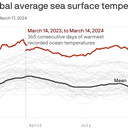"Red Alert to the world": Record warmth in global oceans hits one-year mark

Global ocean surface temperatures have been at record highs for just over a full year, worrying scientists who don't have a complete understanding of what is driving this trend.
Driving the news: March 14 marked a full year in which global ocean surface temperatures were the warmest on record.
Zoom in: Conditions at sea have affected the weather on land, worsening flooding rains in Los Angeles, San Francisco, the East Coast of the U.S. and other parts of the world.
- They have also brought damaging marine heat waves to the ocean, devastating marine ecosystems from the North Atlantic Basin to Australia's Great Barrier Reef.
- Unusually mild ocean and air temperatures were, to some extent, expected in 2023 due to the development of a strong El Niño event in the tropical Pacific Ocean.
- Such events typically feature unusually warm waters in the equatorial tropical Pacific, and can transfer more heat into the atmosphere as well.
Yes, but: The spike in global temperatures seen during 2023, which has continued into 2024, has been unexpected in its magnitude, persistence and geographic extent.
- El Niño simply cannot explain all of it, scientists told Axios.
The intrigue: "I do not have any solid explanations for it," Brian McNoldy, a senior researcher at the University of Miami in Florida, told Axios in an email, regarding the record warm sea surface temperatures.
- "I would say that I'm just a shocked observer like so many others. It's not just that the global-average sea surface temperature has been record-breaking every single day… but it's the absurdly-large margins by which the records have been broken," he said.
- McNoldy said that by late summer of 2023, global records fell by over 0.3°C (0.54°F). "Historically such records were broken only briefly by perhaps half of that margin."
- He said El Niño helped, but was not the only culprit.
What's next: In addition, while there is day-to-day variability that offers fleeting glimpses of downward trends, there are no signs of a global ocean temperature cooldown anytime soon, even with a La Niña expected to develop in the tropical Pacific by the fall.
Between the lines: According to a comprehensive 2023 climate report released Tuesday by the World Meteorological Organization, a UN agency, the global ocean experienced an average daily marine heatwave coverage of 32% last year, beating the previous record of 23% in 2016.
- Marine heat waves were particularly widespread in the North Atlantic and Mediterranean Sea, the WMO noted.
What they're saying: Commenting on 2023's global average surface temperature, which was nearly 1.5°C above pre-industrial levels, WMO Secretary-General Celeste Saulo stated: "Never have we been so close – albeit on a temporary basis at the moment — to the 1.5° C lower limit of the Paris Agreement on climate change."
- "The WMO community is sounding the Red Alert to the world," Saulo said in a statement.
Go deeper:
Scientists "uneasy" about Earth's sped-up warming
Data: Global warming may be accelerating
February is continuing Earth's record warm streak
Editor's note: This story has been updated with details of the WMO's new climate report.